Skeerders Dire Solifugid of Khabissol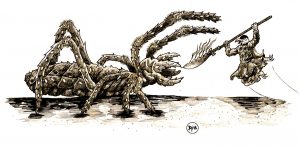
Gehenna’s Gossamer is one of the largest natural structures in the Universe, a colony organism that spans the hard vacuum between three moons of this great crimson world. The Gossamer is biologically comparable to both fungi and plants; the majority of its mass is distributed in miles-long strands similar to fungal hyphae or bamboo, while its metabolism is very like that of an alien plant in that it uses stellar radiation to generate chemical energy. It differs in several crucial ways from both types of organism, however. The most notable distinction is that the Gossamer is capable of thermo-genesis as well as photosynthesis. It also processes the mineral content of the moons directly to the colossal hyphae; gutting the planetoids surface and causing a mass transference to the Gossamer proper. In the space between its colony planetoids, the Gossamer’s metabolic processes create an actual space-borne ecosystem by generating that rarest of materials: breathable gas.
Despite this miraculous adaptation of the unforgiving cold of space, and even with the modicum of heat that its hyphae generate, the Gossamer between the three planetoids is a frigid and inhospitable environment. Most organisms and Daemons deal with the cold by maintaining slow metabolic processes to conserve valuable energy. In this realm of plodders, however, there is a creature that could outrun even the mercury-blooded soldiers of Phlegethos: the giant solifugid, enormous relative of comparatively mundane camel spiders. Like their tiny cousins on mortal worlds, the giant solifugids are fast-moving predators with fearsome mouthparts that can rip through the toughest chitin to get to the soft organs beneath. These creatures prowl the space-borne sections of the Gossamer at a full sprint, dashing in and ripping anything smaller than themselves to bloody ribbons. In the Gossamer, though, arachnids aren’t just huge: some gain a modicum of cunning and a heavy dose of malice. Known collectively as Skeerders, but more commonly called Dire Solifugids, each have a soul from some twisted mortal firmly tied to their chitinous form.
Buy Giant Spiny Solifugid at the Bazaar
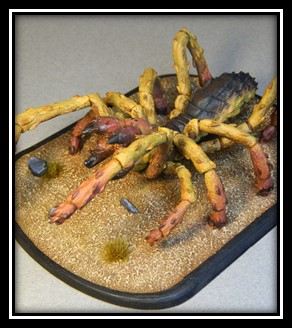
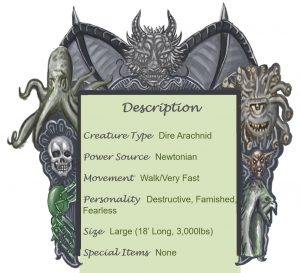 The Dire Solifugid is an almost serpentine creature, with a long and low-slung body. The beasts stand as tall as oxen, but are nearly three times as long and twice as heavy. Long legs inflate their overall size to that of a cottage; documented encounters invariably describe the creature to be even larger still. Such great mass and a high metabolism require Skeerders to be extremely active and efficient hunters. Consequently, they have an unbelievably varied diet. Unlike most other arachnids, they are able to ingest solid food, and their unique digestive systems seem able to derive nutriment from most material, organic and inorganic alike. Specimens have been dissected to find pieces of dozens of smaller species of Gossamer fauna, as well as chunks of larger beasts, gossamer hull fragments, pitted rocks, and the limbs of mortals and Daemons alike.
The Dire Solifugid is an almost serpentine creature, with a long and low-slung body. The beasts stand as tall as oxen, but are nearly three times as long and twice as heavy. Long legs inflate their overall size to that of a cottage; documented encounters invariably describe the creature to be even larger still. Such great mass and a high metabolism require Skeerders to be extremely active and efficient hunters. Consequently, they have an unbelievably varied diet. Unlike most other arachnids, they are able to ingest solid food, and their unique digestive systems seem able to derive nutriment from most material, organic and inorganic alike. Specimens have been dissected to find pieces of dozens of smaller species of Gossamer fauna, as well as chunks of larger beasts, gossamer hull fragments, pitted rocks, and the limbs of mortals and Daemons alike.
The species is also unique for its means of respiration. Instead of the “book lungs” of their spider cousins, Skeerders have respiratory slits underneath their abdomens that create a constant negative pressure to draw in air. Close to the fibers of the Gossamer, these slits draw waste gasses from the fibers before they dissipate into space and store them in a system of tubules that maintain high pressure at a low temperature to render the gasses liquid until they are needed for metabolism. This constant flow of air through the tubules creates the distinctive soft sound of the Skeerders – that of a high pitched, wheezing pipe organ.
The Dire Solifugid has two different circulatory systems working in concert. Due to its location and the creatures’ speed, it is exceptionally difficult to deal significant damage to their secondary circulatory systems, but the effect of a lucky strike can be devastating: the entire creature depressurizes over the course of a second; turning inside-out like a popcorn kernel. This technique only works when the main vessels are damaged, since lesser peripheral vessels have valves in place to prevent catastrophic decompression. The “lucky” assailant is usually slain nigh-instantly by glassy-edged fragments of exoskeleton and a gout of pressurized digestive acid strong enough to dissolve granite. These main vessels can be found in the head just above and behind the brain, and nestled deep in the creature’s abdomen.
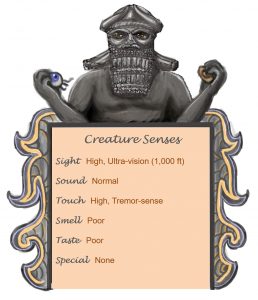 Unlike most other creatures of the Gossamer, Dire Solifugids have exceptional vision, with two anatomically advanced eyes on top of prodigious heads. Dire Solifugids have four sets of legs and one “false” pair closest to their heads. They rely as much on touch as they do sight, and do most of their locomotion with the hindmost three pairs of legs while the false pair tap about their environment like a blind man’s cane. These are exceptionally sensitive, able to distinguish fine distinctions of temperature and texture. Skeerders at a full run can move faster than a horse can gallop, but are capable of anchoring their rear legs almost instantly to stop when they touch or see something edible. Perhaps as a consequence of their visual and tactile acumen, Dire Solifugids do not have the olfactory capacities of other hunters. They have nevertheless demonstrated an uncanny ability- documented in several accounts- to track prey through miles of winding tunnels and unlit webbing.
Unlike most other creatures of the Gossamer, Dire Solifugids have exceptional vision, with two anatomically advanced eyes on top of prodigious heads. Dire Solifugids have four sets of legs and one “false” pair closest to their heads. They rely as much on touch as they do sight, and do most of their locomotion with the hindmost three pairs of legs while the false pair tap about their environment like a blind man’s cane. These are exceptionally sensitive, able to distinguish fine distinctions of temperature and texture. Skeerders at a full run can move faster than a horse can gallop, but are capable of anchoring their rear legs almost instantly to stop when they touch or see something edible. Perhaps as a consequence of their visual and tactile acumen, Dire Solifugids do not have the olfactory capacities of other hunters. They have nevertheless demonstrated an uncanny ability- documented in several accounts- to track prey through miles of winding tunnels and unlit webbing.
Their jaws, too, are very sophisticated; each possesses a dual set of powerful pincer-like chelicerae that can quickly chew through flesh, bone, and even metals, and each set works independently of the other. Mention is made in every account of the Dire Solifugid of its mandibles. These are biological marvels, hydraulic pincers of a power nearly unmatched in the natural world. Part of the complex Solifugid circulatory system is a living “pump” that supplies both sets with terrifying levels of pressure, enough to crumple steel plate like tin. The mandibles themselves are lined with scores of tiny surface channels that use capillary action to transfer digestive fluids from the mouth, further weakening flesh and armor. One bite generally suffices to slay creatures as large as a war horse. Such singular strength, however, cannot come without vulnerability. Deep beneath a marble-hard carapace tough enough to stop ensorcelled arrows unscathed, their flesh contains the pressure of geysers.
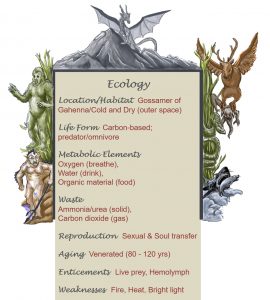 As one of the few apex predators of its ecosystem, the Skeerder will attack almost any creature on sight, including other large Dire arachnidae such as the Qavadakar. Like the sharks of Veldon’s oceans, they roam the spaceward side of the Gossamer’s cyclopean strands, chewing into their heart to attack convenient prey. Although they look much like the more mundane predators of the Gossamer and of mortal worlds, Skeerders are set apart by their taste for sentient flesh and their cunning skill in both decisive strikes and efficient butchery. Given opportunity, they often kill more than they can eat just for the sake of destroying life. Adults are solitary creatures, and carve out large territories for themselves demarcated by complex bands of mandible-made scratches on the hyphae walls that identify specific individuals. These territories are large and jealously guarded, even from members of the opposite sex – it takes
As one of the few apex predators of its ecosystem, the Skeerder will attack almost any creature on sight, including other large Dire arachnidae such as the Qavadakar. Like the sharks of Veldon’s oceans, they roam the spaceward side of the Gossamer’s cyclopean strands, chewing into their heart to attack convenient prey. Although they look much like the more mundane predators of the Gossamer and of mortal worlds, Skeerders are set apart by their taste for sentient flesh and their cunning skill in both decisive strikes and efficient butchery. Given opportunity, they often kill more than they can eat just for the sake of destroying life. Adults are solitary creatures, and carve out large territories for themselves demarcated by complex bands of mandible-made scratches on the hyphae walls that identify specific individuals. These territories are large and jealously guarded, even from members of the opposite sex – it takes
Like all Dire arachnoids in the Gossamer, Khabissol has a hand in guiding murderous souls to their target Skeerder bodies; this “Soul Attachment” is a closely-guarded secret that many Daemon Paragons use to create legions of vicious and cunning warbeasts. During the infrequent seasons of breeding, Khabissol sends legions of slaves and skilled Daemonic artisans of flesh-sculpting into the Gossamer’s wilds, but the known details of the Spider Queen’s specific process are precious few. All that is sure is that the Dire clades’ creation requires the blood of scores of unfortunate mortals, and that the throngs of slaves that enter the wilds of the Gossamer are never seen again.
Khabissol breeds two main types of Dire Solifugid in her dominion: the Baardskeerders and the Haarskeerders. These are derived from two subspecies of giant solifugid- the “spiny” and the “shaggy,” respectively- and each has uniquely terrifying traits that give it an edge on the hunt. The Baardskeerder is slightly smaller, and bears hundreds of thin quills on every surface of its body. These are both a defense against the few other large predators of the Gossamer and a weapon; Dire Spiny Solifugids engage their foes and prey alike by throwing themselves bodily into the fray, hoping to inflict as much incidental damage as possible. Their territories are easily distinguished by the glassy, barbed quills embedded in the webbed hyphae where they have travelled. Haarskeerders leave no such telling sign but for the rare cast molt common to all of the species. They are larger creatures adapted to remain hardy in the depths of space, able to withstand hard vacuum for days at a time. Their shaggy “fur” acts as an insulator as well as a burr-like trap for floating objects and food scraps; the Dire Shaggy Solifugid is notable for its near-continuous grooming behavior at rest. These are also the type most likely to be mutated by cosmic rays. Specimens have been seen with multiple heads and extra pairs of legs. Each type may interbreed with the other, though their heredity is unclear and a heterogeneous union sometimes produces sterile offspring.
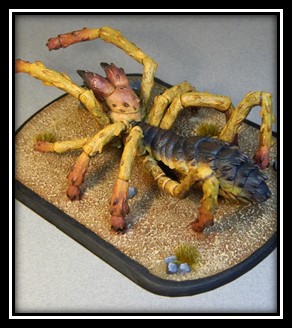
Buy Giant Spiny Solifugid at the Bazaar
Both varieties of Dire Solifugid are efficient hunters from birth, and like the lion or the hydra they are supremely confident in their position at the summit of the food chain. They will attack even the few creatures of their own size without hesitation. A thick carapace and powerful mandibles allow them impunity in their recklessness against even some of the Grim Clade creatures in the cores of the hollowed-out moon Akob or tunnel-riddled Romm. The very largest specimens have even been seen to slay such behemoths as the Grim Ogre Spider, though such encounters are exceedingly rare.
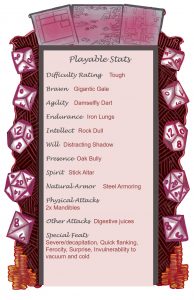 Baardskeerders prefer to attack from unexpected directions; the thin air of the Gossamer makes their footfalls and the sound of their keening breath hard to discern, but no matter how quickly they gnaw through the Gossamer’s outer walls they can rarely take prey completely unawares. Instead, they enter the hyphae some small distance away from prey, and favor fast flanking maneuvers, running around groups to attack the outermost creature. They seem to have an uncanny ability to pick those least suited for physical engagements. Cruel experimentation of Khabissol’s lieutenant Xyubec has confirmed a bias within the species for attacking mages. The cause of this trait seems linked to the souls that merge with the Baardskeerders – perhaps derived from barbaric humanoids with a strong fear of magic. The Dire Spiny Solifugid in general appears to prefer hunting herds of smaller creatures to one or two large prey animals, but this may be more an adaptation to the available prey species in their frigid environs than a concession to sensible risk.
Baardskeerders prefer to attack from unexpected directions; the thin air of the Gossamer makes their footfalls and the sound of their keening breath hard to discern, but no matter how quickly they gnaw through the Gossamer’s outer walls they can rarely take prey completely unawares. Instead, they enter the hyphae some small distance away from prey, and favor fast flanking maneuvers, running around groups to attack the outermost creature. They seem to have an uncanny ability to pick those least suited for physical engagements. Cruel experimentation of Khabissol’s lieutenant Xyubec has confirmed a bias within the species for attacking mages. The cause of this trait seems linked to the souls that merge with the Baardskeerders – perhaps derived from barbaric humanoids with a strong fear of magic. The Dire Spiny Solifugid in general appears to prefer hunting herds of smaller creatures to one or two large prey animals, but this may be more an adaptation to the available prey species in their frigid environs than a concession to sensible risk.
Haarskeerders are no less fearsome than their more common spiny cousins, but are slightly more calculating about engaging their prey. Sometimes known as “trap-door killers,” Haarskeerders will clip cork-shaped portals from the sides of the outer hyphae or reuse the slightly smaller holes made by the giant Horned Spider, saving the time and energy that their smaller brethren spend chewing through the outer wall of the hyphae. The vacuum of space dramatically muffles their piping and their footfalls, and allows them to ‘listen” for the vibration signature of larger prey moving about with their sensitive pedipalps– suddenly popping the makeshift door open to embrace the local flora (or soft foreign morsel) with waiting jaws. Once they’ve engaged, Haarskeerders fight to the death just as ferociously as the Baardskeerder do, allowing their heavy carapace and clinging “fur” to deflect and absorb blows while they tear their targets limb from limb. Certainly the larger of the two subspecies, the Dire Shaggy Solifugid prefers one or two large prey creatures to groups of weak foes. This makes them dangers to Daemons of all types; and when travelling in areas known to harbor Haarskeerders, many such Outsiders carry special devices to keep the arachnoids at bay.
Dire Solifugids are encountered by humanoids most often in the Gossamer, where explorers, adventurers, and traders run afoul of them often in the outer reaches of hyphae. The wilder area between the web-choked Daemon city of Yntrent and far-flung Hema, in particular, are plagued by the huge predators, and travelers are advised to travel the deeper and darker ways betwixt them to avoid causing dangerous external vibrations. These routes have their own dangers; the giant centipedes, in particular, claim a fair number of travelers, and roving Daemons nearly as many. In the event of an encounter, camouflage is effective if those endangered can find cover to eliminate the vibrations of their fearful heartbeat. Otherwise there is little effective defense to be made beyond the judicious application of intense heat to the pedipalps, which is likely to at least temporarily ward off the creature.
Baardskeerders can be found outside the Gossamer – roaming the arid mountains of the mortal world called Duufa. These miles high deserts are home to the fearsome Duufa Ogres, humanoids of great strength and surprising ingenuity. Here the Baarskeerders are worshipped as living demigods. The warlike race considers the Skeerders to be divine emissaries of their war goddess, and the monsters are allowed to roam the sand covered slopes during the cold nights chasing down the biggest creatures that they can find to feed their endless hunger. Duufa Ogres regularly use Dire Solifugid carapace in weapon and armor manufacture, or even just the creation of clothing. It is rumored that some of the greatest Ogre Kings have ridden Skeerders into battle, though this claim is dubious at best and records disagree on the details of each such event.
Like other arachnoid denizens of the Gossamer, few mortal mages have reason to summon the Dire Solifugid beyond pure and unfettered malice. Unlike the Dire Solifugids, the Grim Solifugids have a more clearly discernable intelligence, but are otherwise no less destructive; the difference amounts to being able to choose the direction of the swathe of destruction that the creature carves through the unsuspecting countryside, since even the most clever Grim are little inclined to communication, and are hard pressed to outwit the relatively bookish Dark Vinegaroon by comparison. Daemon mercenary groups have fitted some individuals of all three types with summoning bands – with many casualties – and sometimes call the creatures to function as siege-breakers, but their use is always a double-edged sword. The shaggy Solifugids, in particular, are likely to be disoriented by their sudden change in environment and to attack familiar Daemon targets. Traditional summoners have the best results with extremely frigid summoning locations and buckets upon buckets of warm hemolymph mixed with blood.
